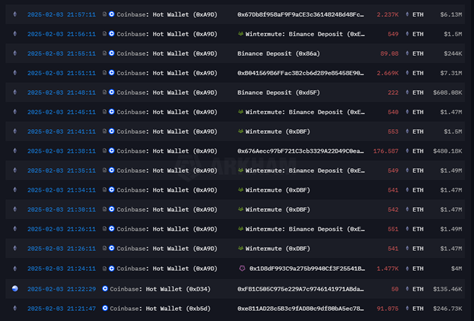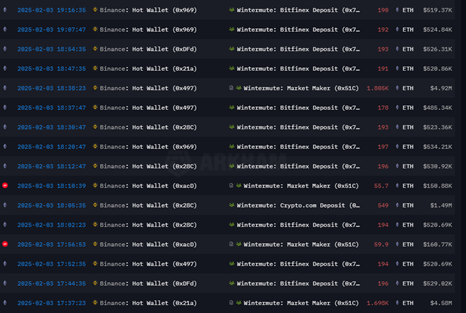Ethereum’s Sudden Crash: A Manipulated Market Event

Ethereum’s sharp decline suggests a calculated liquidation event, leveraging the market and triggering massive sell-offs. Trade wars may be volatile, but the announcements surrounding them provide the perfect cover for market makers looking to manipulate prices.
Ethereum Price Crashes
Over the weekend, US President Donald Trump’s announcement of a tariff hike opened the door for Ethereum market makers to carry out one of the most significant short-term manipulations in the cryptocurrency market.
Ethereum prices fell significantly on Sunday night as the second-largest cryptocurrency lost more than 36% of its value. Within hours, ETH fell to $2,100, resulting in more than $600 million in leveraged positions being liquidated. However, the drop was short-lived as the market quickly took advantage of the opportunity to buy at a discount.
Ethereum recovered more than 17%, rising to $2,500, and by Monday, it had recovered all of its losses, reaching $2,900. By Tuesday, ETH was trading at around $2,700.
However, many analysts believe that this was not a natural market move, but a controlled liquidation event manipulated by crypto market makers.
Signs of Market Manipulation
According to a report from 10X Research, Ethereum's collapse was fueled by over-leveraged ETH futures positions, combined with aggressive put options buying. This led to delta hedging, amplifying the sell-off as President Trump's comments on tariffs caused panic in the market.
Many other analysts share the same view. Trader @DrProfitCrypto believes that this was a targeted liquidation event, targeting ETH.
“The big cartel (Binance and Coinbase) sent a large amount of ETH and BTC to Wintermute market makers to trigger the controlled liquidation event we just saw. This is the biggest hit to ETH!” he wrote on X.
According to this theory, major exchanges may have colluded with Wintermute, forcing leveraged long positions to be liquidated and triggering a massive sell-off.
Market makers benefit from the volatility, as they can buy in at low prices after retail traders and overleveraged positions are wiped out. If large players want to buy ETH at lower prices, creating a quick crash will help them accumulate assets before the price recovers. How Market Makers Trigger Liquidations
Price manipulation typically occurs in three main steps:
Dump a large amount of ETH on the spot market to create downward pressure on the price.
Open large short positions on perpetual futures while continuing to sell on the spot market to push the price further down.
As the price of ETH declines, overleveraged long positions are liquidated, triggering an automatic sell-off that pushes the price even lower.
With thin market liquidity, even a small sell-off can have a disproportionate impact. Market makers then unwind their buy orders, allowing the price to fall further. Once the liquidation is complete, they buy back the ETH at a lower price, profiting from the manipulation.
On-Chain Data Shows Anomalies
The key question is whether the on-chain data supports this manipulation hypothesis. Were there unusual transactions, such as large transfers of ETH from exchanges to market makers before the price crashed?
According to Arkham Intelligence, on February 3, just before the market crash, Coinbase transferred $11.86 million worth of ETH to Wintermute’s deposit addresses on Binance.

At the same time, Binance also had similar transactions where millions of dollars of ETH were transferred to Wintermute’s wallets on multiple exchanges.

Furthermore, Lookonchain’s X-account reported that an Ethereum whale who had been inactive since 2019 deposited 77,736 ETH ($228.6 million) to Bitfinex just before the ETH price crash.
Just hours later, the panic began, with Ethereum leading the crypto market’s collapse. In total, over $600 million in ETH positions were liquidated, accounting for the majority of the $2.1 billion in value wiped off the market.
Why Is Ethereum a Target?
Ethereum has a massive derivatives market, providing massive leverage. When ETH is liquidated, the ripple effect will affect the entire DeFi ecosystem, forcing collateralized loans to close and increasing selling pressure.
This makes ETH an ideal target for market makers, as they can easily manipulate prices and profit from volatility.
